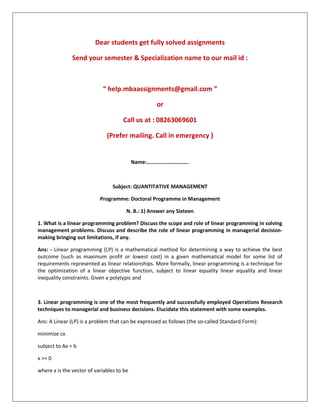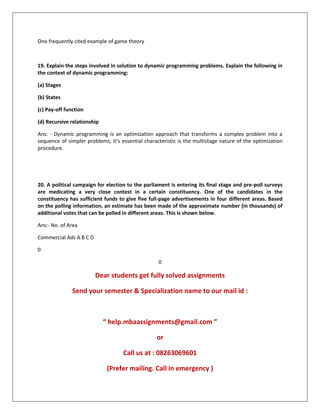This document provides information about obtaining fully solved assignments from an assignment help service. Students are instructed to send their semester, specialization, and contact details to the provided email address or call the phone number to receive help with their assignments. The document includes sample assignments covering topics in quantitative management, with questions regarding linear programming, inventory management, queuing theory, simulation, game theory, and dynamic programming.


![situations. What is queuing theory? In what types of problem situations can it be applied successfully?
Discuss giving examples.
ANS:
It is a collection of mathematical models of various queuing systems.
It is used extensively to analyze production and service processes exhibiting random variability
in market demand (arrival times) and
8. What is a replacement problem? Describe some important replacement situations and policies.
Briefly explain the costs which are relevant to decisions for replacement of depreciable assets.
Illustrate their behavior and explain how the optimal time for replacement of an asset can be
determined.
ANS: In any system , the efficiency of an item deteriorates With time. In such cases, either the old item
should be replaced by a new item, or some kind of restorative action [ maintenance] is necessary to
restore the efficiency of the whole system. The cost of maintenance depends upon a number of factors,
and a stage comes at which the maintenance cost is so large ,it is more profitable to replace the old
item.
THE VARIOUS TYPES OF REPLACEMENT PROBLEMS ARE:
9. What kinds of decision-making situations may be analysed using PERT and CPM techniques? State
the major similarities between PERT and CPM. Under what circumstances is CPM a better technique
of project management than PERT? A construction company has received a contract to build an office
complex. It has frequently engaged itself in constructing such buildings. Which of the two network
techniques, PERT and CPM, should in your opinion, be employed by the company? Why?
ANS : PERT and CPM, acronyms for "program evaluation and review technique" and "critical path
method", respectively, are network techniques used to aid in the planning, scheduling, monitoring, and
control of activities which are related to each other. For example, CPM is frequently used in the
construction industry to help organize and schedule those activities which together constitute a given
construction project. PERT was first used to help coordinate the activities in the development of the
Polaris missle system. PERT and CPM differ from each
10. Describe the steps involved in the process of decision making. What are payoff and regret
functions? How can entries in a regret table be derived from a pay-off table?
Ans: - Step 1: Define the “problem”
It is impossible to make a rational decision unless you can clearly define the problem or context in which
the decision needs to be made. Why does a decision need to be made? What will be the outcome if no
decision is made? What outcome is desired? What is preventing that outcome from being realized?](https://image.slidesharecdn.com/quantitativemanagement-140828035950-phpapp01/85/Quantitative-management-3-320.jpg)



